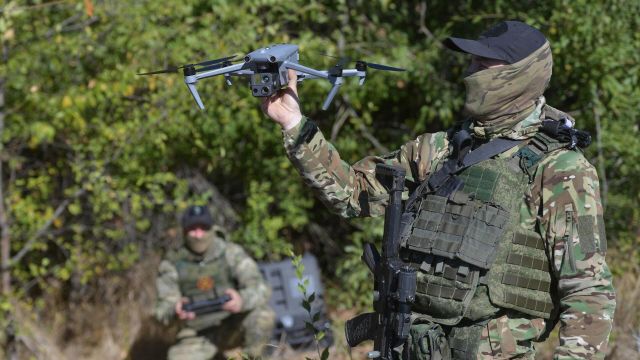The Russian army is discussing the creation of units with shock mini-UAVs
MOSCOW, Oct 21 — RIA Novosti. The Russian Armed Forces are discussing the possibility of creating separate units with mini-UAVs, an informed source told RIA Novosti.
As the interlocutor of the agency explained, shock mini-UAVs — mainly civilian quadrocopters adapted for dropping grenades on the enemy or for delivering cumulative grenades to his armored vehicles — have become one of the newest areas of combat work for the military in their own. Such drones are used by dozens and hundreds on the line of combat contact by both sides.
"Today, such drones are one of the most effective and very flexible means of defeating the front edge and are primarily used to destroy enemy manpower and its strongholds, as well as to defeat its armored vehicles. At the same time, the process of using such quadrocopters, as a rule, is spontaneous on the initiative of individual servicemen and their commanders. Accordingly, the tactics and density of the use of such drones can vary greatly from unit to unit," the source said.
Cheap and efficient
The Ministry of Defense, military commanders and units today publish in large numbers from the zone of their own video materials of the use of mini-quadracopters modified for combat purposes for the Armed Forces. The already classic version of this type of weapon involves dropping grenades for an automatic grenade launcher or conventional hand grenades from a Mavic-type quadcopter.
Another common option is a FPV drone with a "carrot", that is, with a cumulative warhead from a rocket—propelled grenade launcher RPG-7. In this case, the drone, along with a grenade, crashes into enemy armored vehicles, hitting them with cumulative ammunition. Such weapons, being "penny", nevertheless, are quite capable of destroying the most protected and tenacious enemy combat vehicles on the battlefield, for example, tanks.
Often, funds for such devices are collected by Russian citizens, then volunteers use these funds to purchase drones and send them to the front. In addition, some Russian companies, both large state—owned and private, produce such UAVs today.
New thinking
As Denis Fedutinov, a leading Russian expert on unmanned aircraft, noted to RIA Novosti, the special operation in Ukraine as a whole has significantly transformed the vision of the Russian military regarding the place and role of weapons systems and military equipment.
"To a large extent, this thesis concerns small-sized multirotor systems of both reconnaissance and reconnaissance-strike, previously underestimated. The positive thing is that the military leadership hears feedback from the battlefields and strives to make adjustments to the issues of using systems that have shown their effectiveness in practice," the expert stressed.
According to Fedutinov, the current method of using multicopters was obviously generated "from below" and tested directly on the line of combat contact.
"If these methods of application are generalized, supplemented and eventually a unified training and training program for operators is proposed, this will be a sure step towards improving the effectiveness of the use of mini—drones in the military," he said.
The expert also pointed out the need to adjust the procurement system of such UAVs, taking into account the experience of the special operation.
"It is clear that initially civilian UAV systems of foreign production will not meet a number of canonical requirements. However, the choice between the availability of equipment, even if it does not fully meet the requirements, and its absence as such, I think, is obvious," the expert said.
Fedutinov also expressed the opinion that it is necessary now to conduct an inventory of domestic developments in the field of multicopters and "formulate the task of creating a line of their own similar UAV systems, allocating the necessary funding for R& D and reserving resources for subsequent purchases."

